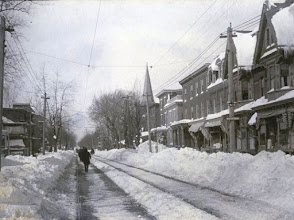Friday, October 26, 2018
Saturday, October 20, 2018
Winter '18 / '19 - How Much For Philly?
A weak-to-moderate El Niño continues to be the consensus forecast for Winter '18 / '19.
Weak-to-moderate El Niño conditions -- defined generally as sea surface temperature anomalies at least 0.5°C above normal near the International Dateline in the tropical Pacific ocean -- correlates with more than a few more inches of snow than average in and around Philly.
One problem; average isn't always the best metric to describe what's typical or most likely to occur. That honor frequently falls to the median.
As such ... the median snowfall is four inches less than the 23" 51-year average suggesting this winter's season-total snowfall in Philly could very be up to seven inches more than most other winters.
Saturday, October 13, 2018
Winter '17 / '18 - Correlation of Eurasia's OCT Snow Cover and Season-total Snowfall in NE and M-A Regions
REPOST from OCT-17 (lightly edited for clarity)
Updated with Winter '17 / '18 verifications for RIC and NYC and their outlooks for Winter '18 / '19
---
The correlation between the areal coverage of Eurasia/s OCT snow cover and season-total snowfall has become broad-brushed conventional wisdom (CW) following the innovative research by AER climatologist Dr. Judah Cohen.
But ... just how well does the CW hold up for NEWxSFC/s forecast stations across New England (NE) and the mid-Atlantic (M-A) regions?
To find out ... monthly period-of-record areal snow cover data for Eurasia from Rutgers Global Snow Lab were correlated with season-total snowfall data for the 27 NEWxSFC/s stations.
A positive and statistically significant correlation means the greater the areal snow cover over Eurasia in OCT ... the greater the season-total snowfall for the following winter.
An Excel radar chart shown below depicts the results of the analysis.
Translation: greater season-total snowfall over select stations in the NE and M-A is correlated with greater OCT areal snow cover in Eurasia.
---
The analysis showed other significant correlations of interest.
- RIC/s season-total snowfall has a positive correlation with Eurasia/s AUG areal snow cover.
Eurasia/s AUG-17 snow cover was well below normal ==> lower season-total snowfall @RIC this winter.
VERIFICATION Winter '17 / '18: RIC STP 12.4" (AVG: 13.2")
OUTLOOK Winter '18 / '19: Eurasia's AUG snow cover below average ==> STP below AVG
- NYC/s season-total snowfall has a negative correlation with Eurasia's JUN areal snow cover.
Eurasia/s JUN-17 snow cover was above normal ==> lower season-total snowfall @ NYC this winter.
VERIFICATION Winter '17 / '18: NYC STP 35.4" (AVG: 26.1")
OUTLOOK Winter '18 / '19: Eurasia's JUN snow cover below average ==> STP above AVG
GREEN (RED): positive (negative) correlation between monthly Eurasian areal snow cover and season-total snowfall.
VERIFICATION Winter '17 / '18
Eurasia's OCT-17 areal snow cover was greater than average (12,051,667 km^2 v 10,261,134 km^2).
Positive correlations for the stations listed below suggest Winter '17 / '18 STP would be above average
STN: STP" / AVG"
ABE: 46 / 31.4
BOS: 58.6 / 41.6
BTV: 81.5 / 69.8
PWM: 91.1 / 63.8
---
FINDINGS: data analysis supports the CW for NE forecast stations but not so much across the M-A.
Thursday, October 4, 2018
Winter '17 / '18 - Arctic Oscillation (AO) Analog Verification
The analog forecasting technique seeks similarities to the AO state in the run-up to the coming winter with AO run-up states of winters past. Presented here is the verification of AO analogs for the '17 /'18 winter.
The NEWxSFC method ranks analog years by their the sum of square errors (SSE) statistic.
Lower SSE errors ==> stronger analog
Constraining the number of analog winters for analysis to five is arbitrary.
 |
| Arctic Oscillation (AO) Index Analog Forecast Verification |
 An alternative forecasting technique looks at the AO/s 'sign' (i.e., positive or negative) for any calendar-year's month preceding the pending winter as a potential leading indicator of the AO's sign for upcoming D-J-F period.
An alternative forecasting technique looks at the AO/s 'sign' (i.e., positive or negative) for any calendar-year's month preceding the pending winter as a potential leading indicator of the AO's sign for upcoming D-J-F period.Results from a chi-square 'test for independence' infers a statistically significant relationship ... at the 95% confidence level and a p-value < 0.05 ... between NOV's AO sign and AO's sign of the upcoming D-J-F period.
IOW ... if NOV's AO is negative (positive) ... then the average AO state during the upcoming winter will also be negative (positive); although the classification model is stronger ... i.e., lower false alarm rate ... for the predictor's month with negative signs than positive. This is opposite of the relationship found for the NAO.
BOTTOM LINE: If NOV's AO is negative ... chances are good the AO state will average negative during the D-J-F period.



























